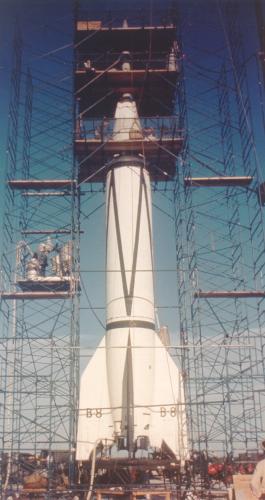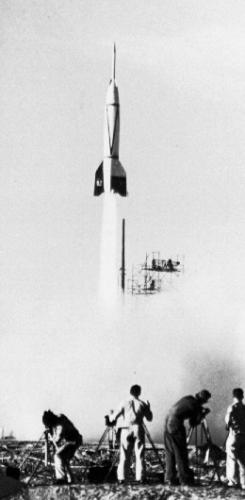General Electric RTV-G-4/RV-A-4 Bumper
In February 1946, the JPL (Jet Propulsion Laboratory) started to study the possibility of a two-stage research missile consisting of a V-2 first stage and a WAC Corporal as the second stage. In October that year, the U.S. Army agreed to fund this project as the Bumper, and assigned overall responsibility to General Electric's Hermes program (for the latter, see page on SSM-A-16 Hermes A-3B). The Bumper would serve two primary purposes. First, it would be the first two-stage liquid-fueled rocket ever built, and as such would explore problems related to stage separation and rocket ignition at high altitude. Second, it would greatly increase the maximum altitude reachable by a small research rocket.
 |
| Photo: U.S. Army |
| RTV-G-4 |
Except for the nose cone, which had to be altered to connect to the WAC Corporal, the V-2 was essentially unchanged. The WAC, however, had to be a bit more extensively modified, leading to the configuration called Bumper Wac. Because it had to fly stable in the thin atmosphere above 40 km (25 miles), the Bumper Wac had four large fins in place of the WAC Corporal's three smaller ones, and additionally had two small solid-fueled spin motors to induce a gyro-stabilizing spin for exo-atmospheric flight. It was carried on the V-2 with its fins recessed into the V-2's nose cone. The staging mechanism worked by reducing the V-2 engine's thrust at a predetermined speed, followed by a signal to the Bumper Wac to ignite its engine. The latter then burned through a wire, thereby signalling V-2 engine cutoff. With the V-2 decelerating, the upper stage could slide out of its rails and begin its free flight.
In February 1948, the designation RTV-G-4 was assigned to the Bumper, and in May that year the first Bumper was launched. It had only a dummy upper stage with a small solid-propellant charge to test stage separation, and did achieve its objectives. The first flight with a live Bumper Wac (the third one) occurred on 30 September 1948, but failed because the Wac's engine exploded on ignition. A design deficiency was tracked down and corrected, and (after a V-2 failure in November), the fifth Bumper flight on 24 February 1949 was the first full success. In that day, the upper stage reached an altitude of 393 km (244 miles), which was a new record for any man-made object. This record would hold several years.
 |
 | |
| Photo: USAF | Photo: U.S. Army | |
| RTV-G-4 | ||
After a V-2 failure on the sixth flight, it was decided that the remaining two Bumpers would be used to fly the Bumper Wac as fast as possible to produce aerodynamic data at unprecedented speeds. For this purpose, the V-2 would fly an arched trajectory and release the Bumper Wac in almost horizontal attitude. These tests needed a firing range with a large open unpopulated area (like the open sea), and the Army selected the area of Cape Canaveral in Florida. Thus the Bumper project became the "founding father" for the world's most famous space launch facility. On the first launch of an RTV-G-4 at the Cape, the upper stage failed to ignite, but the second and final attempt on 29 July 1950 (Bumper flight 8, but actually vehicle #7) was successful and the Bumper Wac reached a speed of 5260 km/h (3270 mph).
In mid-1951, the Bumper's official designation was changed from RTV-G-4 to RV-A-4, although the program was no longer active by then.
Specifications
Note: Data given by several sources show slight variations. Figures given below may therefore be inaccurate!
Data for RTV-G-4:
| Length | 17.25 m (56 ft 7 in) |
| Finspan | V-2: 3.56 m (11 ft 8 in) Bumper Wac: 1.22 m (4 ft) |
| Diameter | V-2: 1.65 m (5 ft 5 in) Bumper Wac: 30.5 cm (12 in) |
| Weight | 12800 kg (28300 lb) |
| Speed | 5260 km/h (3270 mph) |
| Ceiling | 393 km (244 miles) |
| Propulsion | V-2: Liquid-fueled rocket; 267 kN (60000 lb) for 70 s Bumper Wac: Aerojet liquid-fueled rocket; 6.7 kN (1500 lb) |
Main Sources
[1] Peter Alway: "Rockets of the World", Saturn Press, 1999
[2] Frederick I. Ordway III, Ronald C. Wakeford: "International Missile and Spacecraft Guide", McGraw-Hill, 1960
Back to Directory of U.S. Military Rockets and Missiles, Appendix 1
Last Updated: 1 February 2003